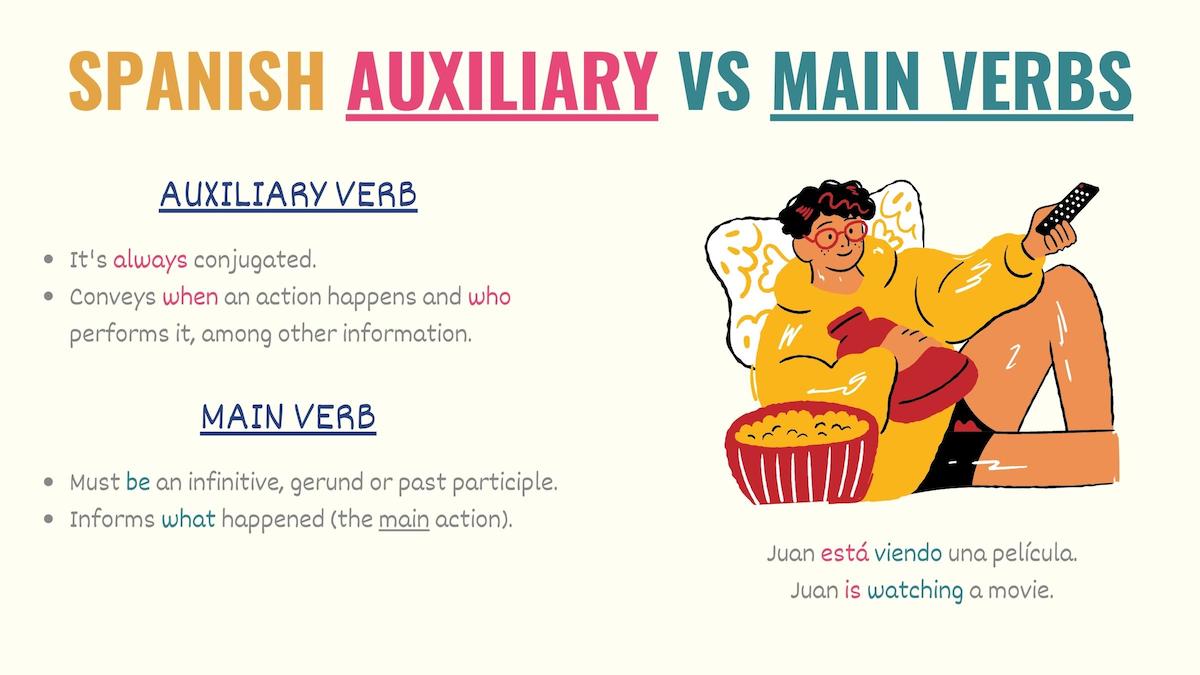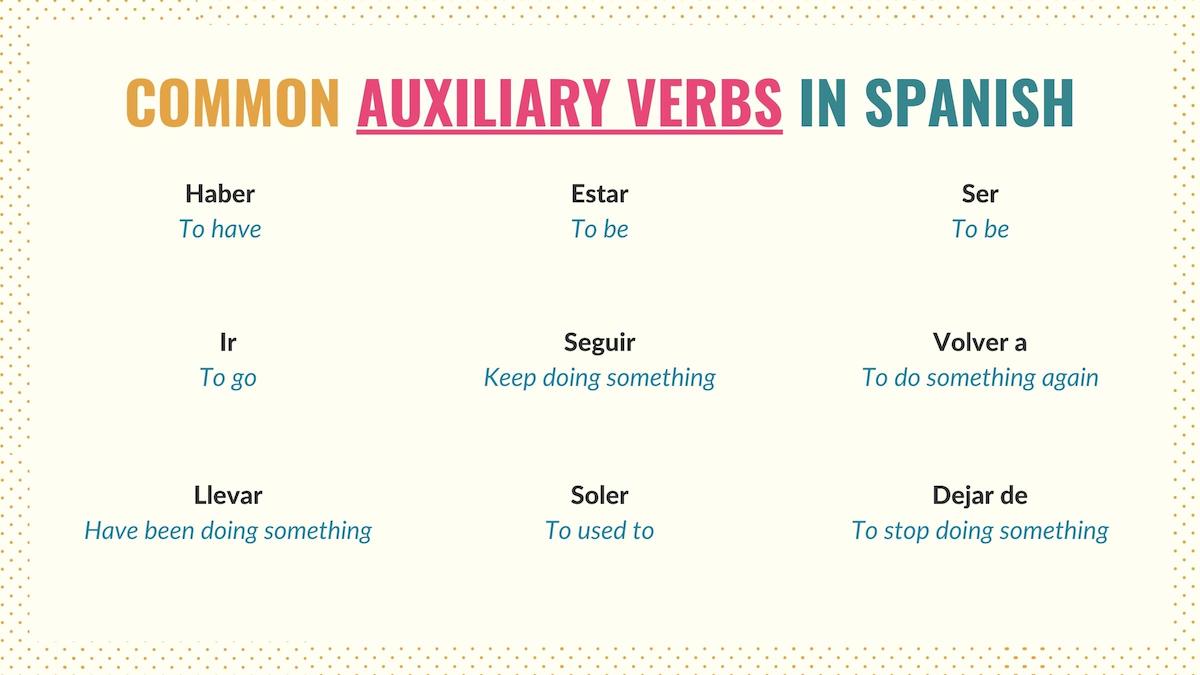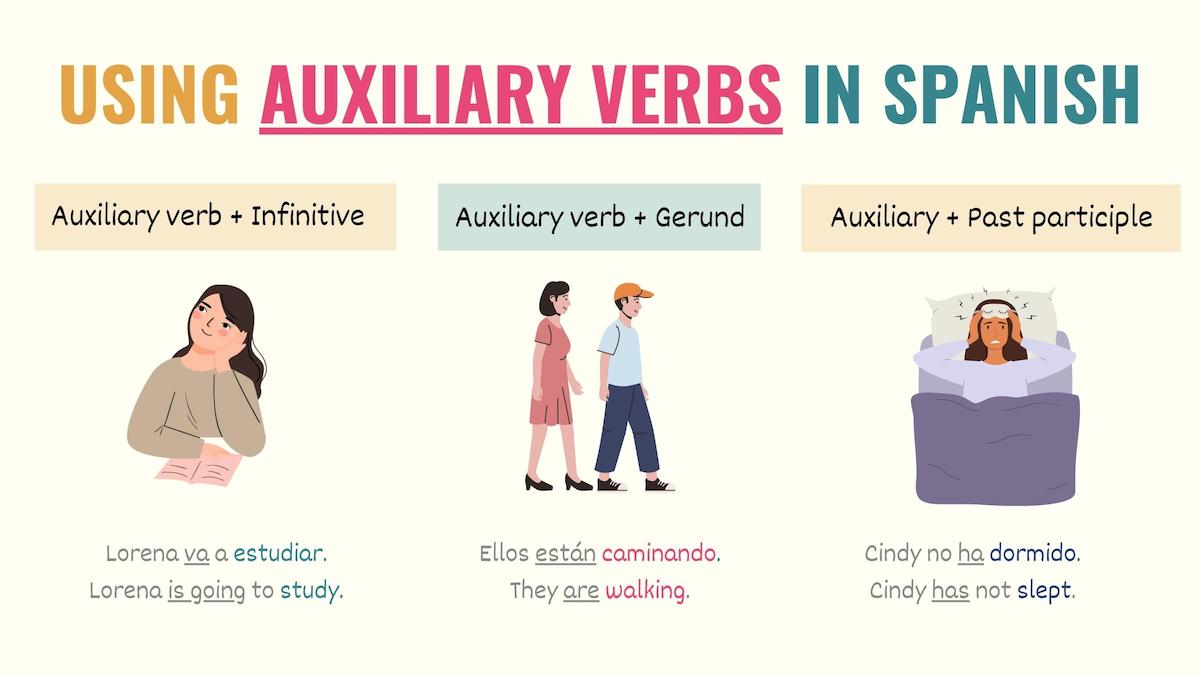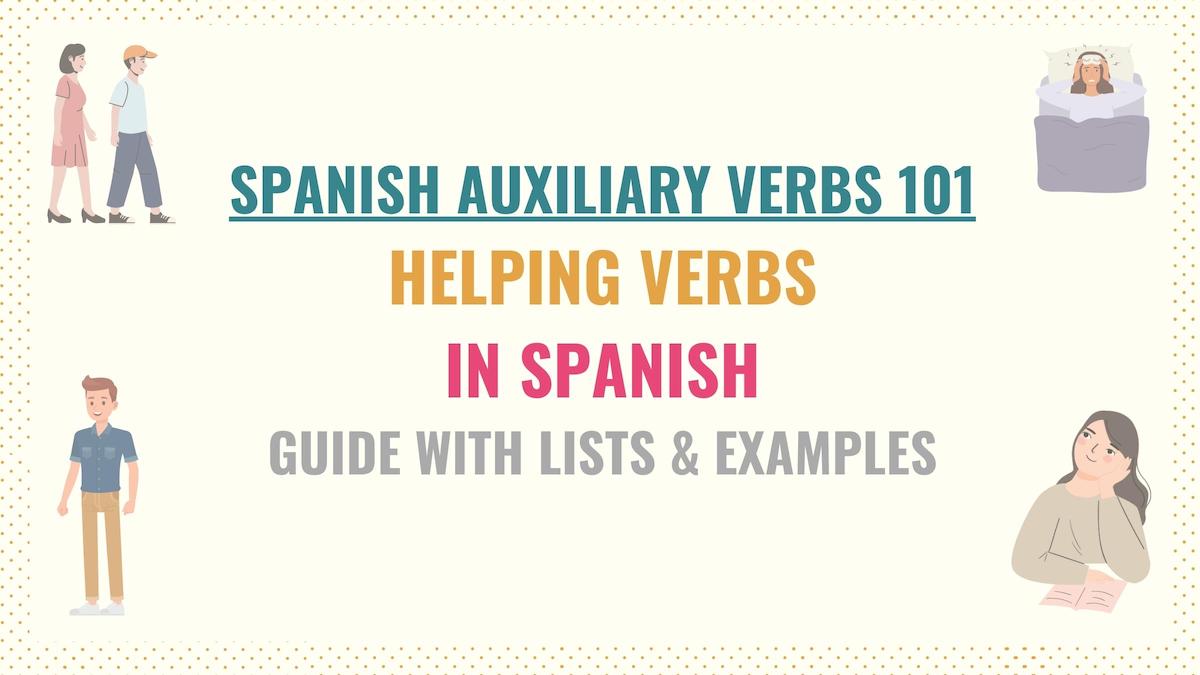Auxiliary verb is a term you’ll often come across with certain Spanish tenses and verbal periphrases. Since this type of verb is crucial for conjugation, here’s what you’ll find in this guide to auxiliary verbs in Spanish:
- What Are Auxiliary Verbs
- List & Examples of Helping Verbs in Spanish
- Key Points
- Additional Resources
- Downloadable PDF
To make things easier, I’ve included sentences with common verbs you should know. Let’s get to it.
What are Helping Verbs in Spanish?
Auxiliary verbs, also called helping verbs, are paired with another verb (main) to form compound tenses (perfect or progressive tenses), passive voice constructions or verbal phrases in Spanish.
In other words, as its name suggests, a helping verb helps you create different structures in Spanish. Unlike the main verb, auxiliary verbs are always conjugated. As a result, they provide crucial grammatical information such as:
- Subject (who performs the action)
- Mood (subjunctive or indicative)
- Tense (when the action takes place)
- Voice (active or passive)
On the other hand, the principal verb of a sentence expresses the action someone is performing and it cannot be conjugated. Simply put, in Spanish, an auxiliary verb must work with past participles, gerunds or infinitive verbs.

Check the Spanish sentences below:
[Auxiliary verb conjugated] + (preposition/conjunction) + [infinitive / participles]
Todavía no he comido.
I have not eaten yet.
La señora está viendo la tele.
The lady is watching TV.
Tuvimos que repetir el proyecto.
We had to repeat the project.
Take sentence #3 as an example. The auxiliary verb (bold) conveys that we did this action in the past.
On the other hand, the principal verb (underlined) tells you what was the action we did. In this case, repeating our project.
As you can see, in the previous examples, you cannot remove any of the verbs without affecting the sentence’s meaning and structure. In the following section, you’ll learn the most important Spanish auxiliary verbs.
Take Note: In Spanish, you can omit the subject pronoun because the ending of a conjugated verb conveys who is performing the action. Also, the auxiliary verb can be conjugated to the present tense, future, conditional, or any Spanish tense you need.
Spanish Vocabulary: List of Auxiliary Verbs

The verbs haber, estar, and ser are three of the most important auxiliary verbs in Spanish. Here are some important notes about them:
- Haber is mostly used to form the perfect tenses (such as the present perfect). In this context, it means ‘to have’.
- Estar allows you to form the progressive tenses (like the present progressive).
- The verb ser is only used as a helping verb to form the passive voice in Spanish.
Although these three Spanish verbs are crucial, they’re not the only helping verbs you should know if you want to be fluent. If you want to improve your Spanish vocabulary and verb conjugation, check the list below with the essential auxiliary verbs you should know.
To make things easier, I’ve classified these terms based on the verbs they can work with (infinitive or participles). Be aware that some of the following verbal phrases may also need a preposition or conjunction.

Take Note: In Spanish, some of the following auxiliaries can work with more than one type of principal verb. Although some of these verbs can stand on their own (like, llevar or seguir), their meaning may change if they’re used as a helping verb.
Helpers for infinitive verbs
- Acabar de: To finish
- Acostumbrarse a: To get used to
- Alcanzar a: To be able to
- Comenzar a: To start
- Deber: Must / Should
- Dejar de: To stop doing
- Empezar a: To start
- Estar por: To be about
- Haber que (impersonal form): Must
- Ir a: Going to
- Necesitar: To need
- Poder: Can / To be able to
- Ponerse a: To start
- Querer: To want
- Saber: To know
- Soler: To used to
- Tener que: To have to
- Venir a: To come to
- Volver a: To do again
[Auxiliary verb conjugated] + [infinitive verb]
Sofía sabe hablar inglés.
Sofía knows how to speak English.
Nosotros solíamos vivir aquí.
We used to live here.
Mañana volveremos a estudiar este tema.
Tomorrow we will study this topic again.
Tenemos que limpiarla otra vez.
We have to clean them again.
Take Note: If your sentence includes direct or indirect object pronouns, you must place these words before the helper verb or attach them to the infinitive.
Helpers for past participles
- Andar: To be
- Estar: To be
- Haber: Have
- Ser: To be
[Helper conjugated] + [past particle form]
Andamos ocupados, ¿qué necesitas?
We are busy, what do you need?
Nunca habíamos visto esa película.
We hadn’t seen that movie before.
La canción fue grabada en este estudio.
The song was recorded in this studio.
Take Note: In Spanish, participles can also work as adjectives. If this is the case, they will have gender and singular or plural form. However, this rule is never applied when working with the verb haber.
Helpers for present participles
- Acabar: To end up
- Andar: To be
- Continuar: To continue
- Estar: To be
- Ir: To go
- Llevar: How long / Have been
- Quedarse: To stay doing something
- Seguir: To keep doing something
- Terminar: To finish doing something
[Auxiliary conjugated] + [gerund]
Yo estoy leyendo ese libro.
I am reading that book.
¿Cuánto llevas estudiando español?
How long have you been studying Spanish?
Todavía seguimos trabajando en este hospital.
We are still working in this hospital.
Take Note: Remember that the verb you must conjugate is the helping verb. Although the previous examples are in the present, you can conjugate to any tense you need. In this guide, you can check different tenses in Spanish.
Key Points for Spanish Auxiliary Verbs
Spanish auxiliary verbs are crucial for conjugation, but also to deliver your ideas clearly. Here are some key points you should remember:
- A Spanish auxiliary verb works with main verbs to build compound tenses, periphrases, or passive voice structures.
- You must always conjugate helping verbs because they provide essential grammatical information such as: tense, subject, mood, and voice.
- In fact, you can conjugate them to any tense and use them in the subjunctive or indicative mood.
- They do not describe what the action is. In other words, they do not carry the meaning of the sentence.
- Auxiliary verbs in Spanish work with gerunds, past participles, and infinitives.
Spanish Auxiliary Verb Additional Resources
Now that you’ve learned how these types of verbs work, here are some next steps you can take. Get familiar with how to conjugate gerunds and past participle forms since you’re going to use them in compound tenses and basic periphrasis.
You should also know what infinitive verbs are and how to use them correctly. Finally, you may want to learn how to conjugate some of these auxiliary verbs. Here are the specific verb conjugation guides you should check out for the most common verbs:
Download the Auxiliary Verbs Cheat Sheet
Auxiliary verbs can be a tricky topic, but it is one which you’ll use and need to learn as a beginner all the way to advanced Spanish. I’ve created a PDF with cheat sheets from this guide which you can download with all the highlights, key points, verbs, uses, and examples.



